Case Study: Fame Decorator Agencies Pty Limited v Jeffries Industries
VerifiedAdded on 2020/04/01
|7
|2017
|223
Case Study
AI Summary
The case study analyzes Fame Decorator Agencies Pty Limited v Jeffries Industries Limited [1998], focusing on allegations of market manipulation related to the conversion of preference shares into ordinary shares listed on the Australian Stock Exchange. The core issue revolves around whether Fame Decorators, through its stockbroker, manipulated the market by selling a large volume of shares at a discounted price in the final minutes of trading to influence the weighted average sale price and, consequently, the number of ordinary shares received upon conversion. The court was divided on the culpability of Fame Decorators, with the majority finding the conduct manipulative due to its intent to artificially depress share prices, while the minority argued that the transactions were a result of market mechanisms. The analysis explores the legal principles of market manipulation, the differing interpretations of intent, and the implications of the decision, including the potential adoption of a broader, implied intent approach to improve the efficiency of market manipulation regimes. The relevance of the decision lies in its implications for the market manipulation regime and the need to address emerging manipulative practices.
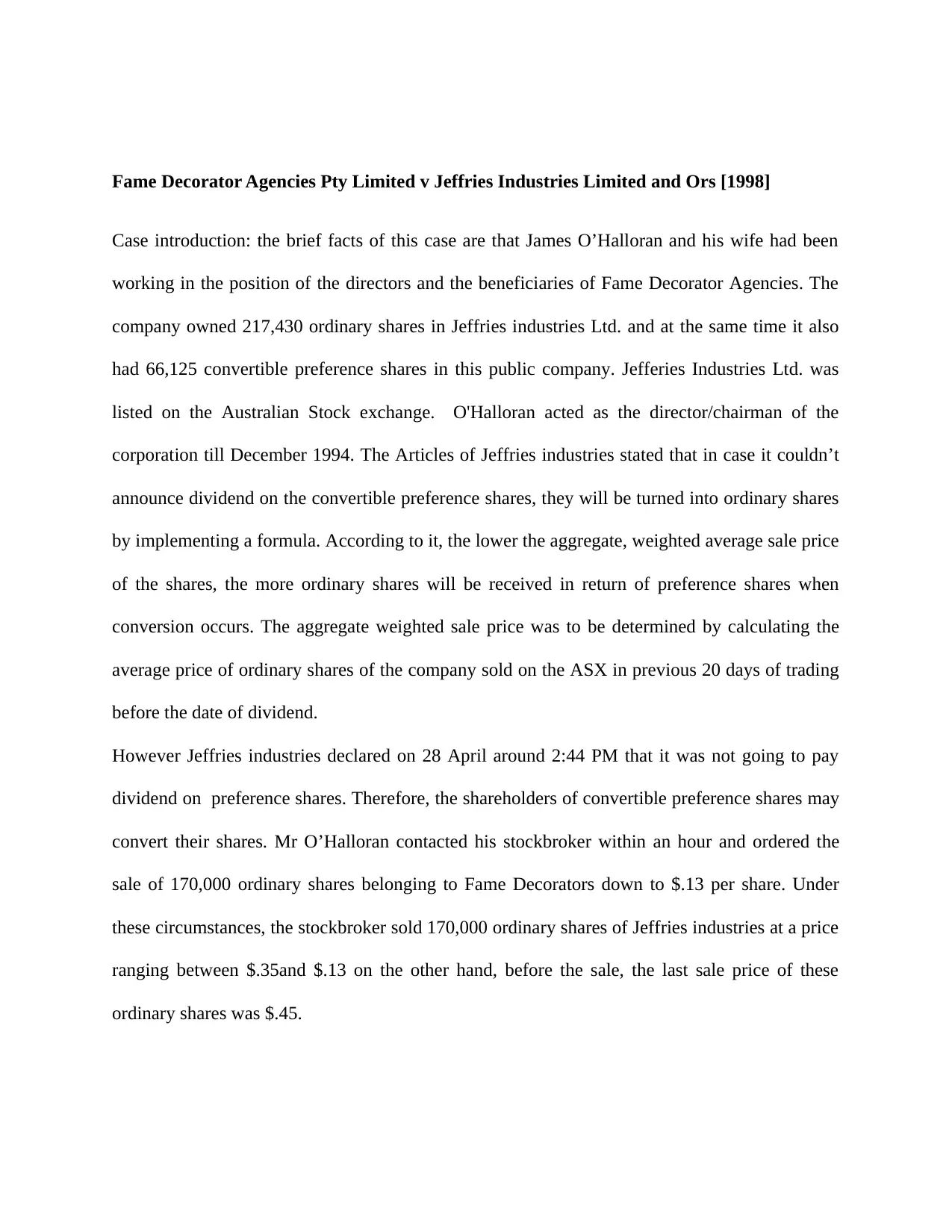
Fame Decorator Agencies Pty Limited v Jeffries Industries Limited and Ors [1998]
Case introduction: the brief facts of this case are that James O’Halloran and his wife had been
working in the position of the directors and the beneficiaries of Fame Decorator Agencies. The
company owned 217,430 ordinary shares in Jeffries industries Ltd. and at the same time it also
had 66,125 convertible preference shares in this public company. Jefferies Industries Ltd. was
listed on the Australian Stock exchange. O'Halloran acted as the director/chairman of the
corporation till December 1994. The Articles of Jeffries industries stated that in case it couldn’t
announce dividend on the convertible preference shares, they will be turned into ordinary shares
by implementing a formula. According to it, the lower the aggregate, weighted average sale price
of the shares, the more ordinary shares will be received in return of preference shares when
conversion occurs. The aggregate weighted sale price was to be determined by calculating the
average price of ordinary shares of the company sold on the ASX in previous 20 days of trading
before the date of dividend.
However Jeffries industries declared on 28 April around 2:44 PM that it was not going to pay
dividend on preference shares. Therefore, the shareholders of convertible preference shares may
convert their shares. Mr O’Halloran contacted his stockbroker within an hour and ordered the
sale of 170,000 ordinary shares belonging to Fame Decorators down to $.13 per share. Under
these circumstances, the stockbroker sold 170,000 ordinary shares of Jeffries industries at a price
ranging between $.35and $.13 on the other hand, before the sale, the last sale price of these
ordinary shares was $.45.
Case introduction: the brief facts of this case are that James O’Halloran and his wife had been
working in the position of the directors and the beneficiaries of Fame Decorator Agencies. The
company owned 217,430 ordinary shares in Jeffries industries Ltd. and at the same time it also
had 66,125 convertible preference shares in this public company. Jefferies Industries Ltd. was
listed on the Australian Stock exchange. O'Halloran acted as the director/chairman of the
corporation till December 1994. The Articles of Jeffries industries stated that in case it couldn’t
announce dividend on the convertible preference shares, they will be turned into ordinary shares
by implementing a formula. According to it, the lower the aggregate, weighted average sale price
of the shares, the more ordinary shares will be received in return of preference shares when
conversion occurs. The aggregate weighted sale price was to be determined by calculating the
average price of ordinary shares of the company sold on the ASX in previous 20 days of trading
before the date of dividend.
However Jeffries industries declared on 28 April around 2:44 PM that it was not going to pay
dividend on preference shares. Therefore, the shareholders of convertible preference shares may
convert their shares. Mr O’Halloran contacted his stockbroker within an hour and ordered the
sale of 170,000 ordinary shares belonging to Fame Decorators down to $.13 per share. Under
these circumstances, the stockbroker sold 170,000 ordinary shares of Jeffries industries at a price
ranging between $.35and $.13 on the other hand, before the sale, the last sale price of these
ordinary shares was $.45.
Paraphrase This Document
Need a fresh take? Get an instant paraphrase of this document with our AI Paraphraser
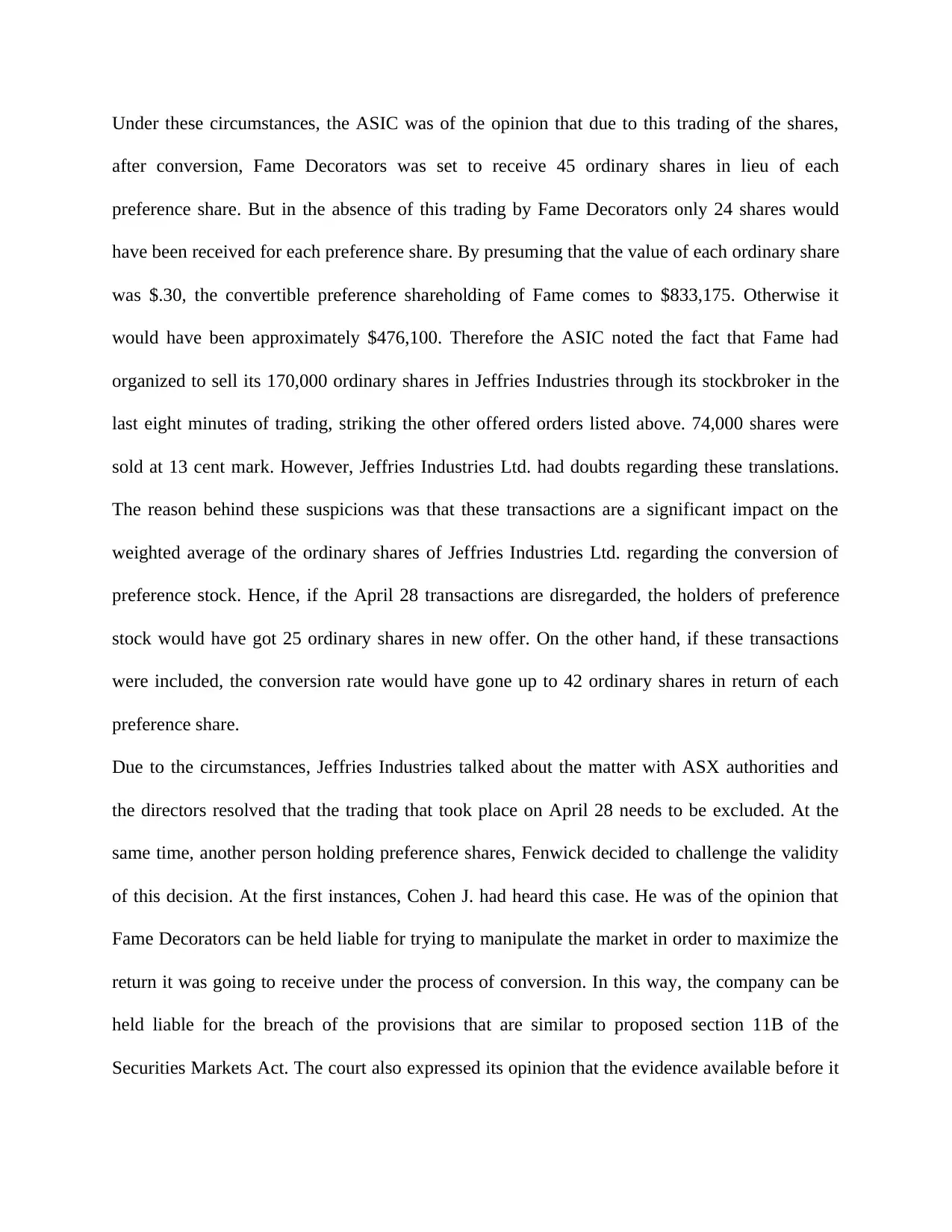
Under these circumstances, the ASIC was of the opinion that due to this trading of the shares,
after conversion, Fame Decorators was set to receive 45 ordinary shares in lieu of each
preference share. But in the absence of this trading by Fame Decorators only 24 shares would
have been received for each preference share. By presuming that the value of each ordinary share
was $.30, the convertible preference shareholding of Fame comes to $833,175. Otherwise it
would have been approximately $476,100. Therefore the ASIC noted the fact that Fame had
organized to sell its 170,000 ordinary shares in Jeffries Industries through its stockbroker in the
last eight minutes of trading, striking the other offered orders listed above. 74,000 shares were
sold at 13 cent mark. However, Jeffries Industries Ltd. had doubts regarding these translations.
The reason behind these suspicions was that these transactions are a significant impact on the
weighted average of the ordinary shares of Jeffries Industries Ltd. regarding the conversion of
preference stock. Hence, if the April 28 transactions are disregarded, the holders of preference
stock would have got 25 ordinary shares in new offer. On the other hand, if these transactions
were included, the conversion rate would have gone up to 42 ordinary shares in return of each
preference share.
Due to the circumstances, Jeffries Industries talked about the matter with ASX authorities and
the directors resolved that the trading that took place on April 28 needs to be excluded. At the
same time, another person holding preference shares, Fenwick decided to challenge the validity
of this decision. At the first instances, Cohen J. had heard this case. He was of the opinion that
Fame Decorators can be held liable for trying to manipulate the market in order to maximize the
return it was going to receive under the process of conversion. In this way, the company can be
held liable for the breach of the provisions that are similar to proposed section 11B of the
Securities Markets Act. The court also expressed its opinion that the evidence available before it
after conversion, Fame Decorators was set to receive 45 ordinary shares in lieu of each
preference share. But in the absence of this trading by Fame Decorators only 24 shares would
have been received for each preference share. By presuming that the value of each ordinary share
was $.30, the convertible preference shareholding of Fame comes to $833,175. Otherwise it
would have been approximately $476,100. Therefore the ASIC noted the fact that Fame had
organized to sell its 170,000 ordinary shares in Jeffries Industries through its stockbroker in the
last eight minutes of trading, striking the other offered orders listed above. 74,000 shares were
sold at 13 cent mark. However, Jeffries Industries Ltd. had doubts regarding these translations.
The reason behind these suspicions was that these transactions are a significant impact on the
weighted average of the ordinary shares of Jeffries Industries Ltd. regarding the conversion of
preference stock. Hence, if the April 28 transactions are disregarded, the holders of preference
stock would have got 25 ordinary shares in new offer. On the other hand, if these transactions
were included, the conversion rate would have gone up to 42 ordinary shares in return of each
preference share.
Due to the circumstances, Jeffries Industries talked about the matter with ASX authorities and
the directors resolved that the trading that took place on April 28 needs to be excluded. At the
same time, another person holding preference shares, Fenwick decided to challenge the validity
of this decision. At the first instances, Cohen J. had heard this case. He was of the opinion that
Fame Decorators can be held liable for trying to manipulate the market in order to maximize the
return it was going to receive under the process of conversion. In this way, the company can be
held liable for the breach of the provisions that are similar to proposed section 11B of the
Securities Markets Act. The court also expressed its opinion that the evidence available before it
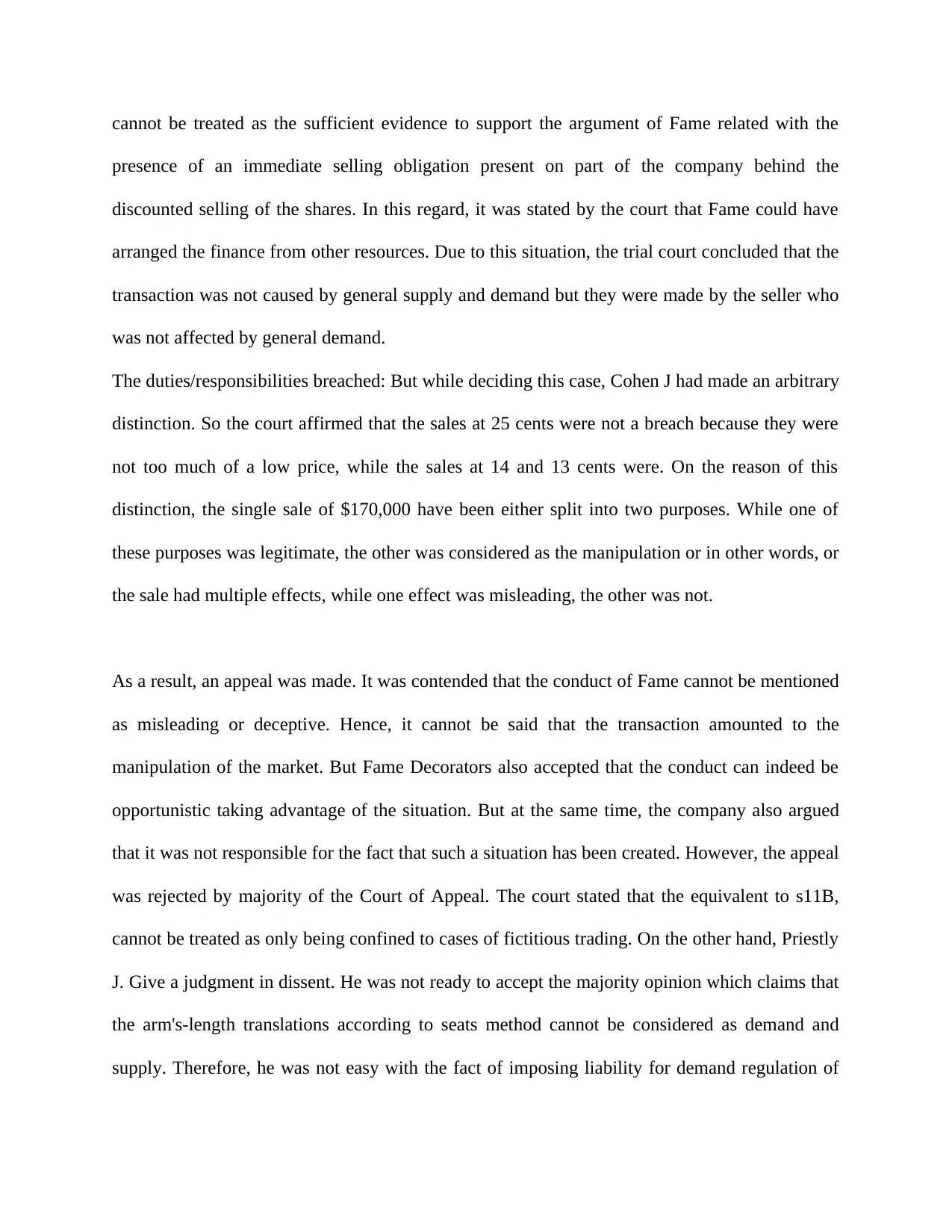
cannot be treated as the sufficient evidence to support the argument of Fame related with the
presence of an immediate selling obligation present on part of the company behind the
discounted selling of the shares. In this regard, it was stated by the court that Fame could have
arranged the finance from other resources. Due to this situation, the trial court concluded that the
transaction was not caused by general supply and demand but they were made by the seller who
was not affected by general demand.
The duties/responsibilities breached: But while deciding this case, Cohen J had made an arbitrary
distinction. So the court affirmed that the sales at 25 cents were not a breach because they were
not too much of a low price, while the sales at 14 and 13 cents were. On the reason of this
distinction, the single sale of $170,000 have been either split into two purposes. While one of
these purposes was legitimate, the other was considered as the manipulation or in other words, or
the sale had multiple effects, while one effect was misleading, the other was not.
As a result, an appeal was made. It was contended that the conduct of Fame cannot be mentioned
as misleading or deceptive. Hence, it cannot be said that the transaction amounted to the
manipulation of the market. But Fame Decorators also accepted that the conduct can indeed be
opportunistic taking advantage of the situation. But at the same time, the company also argued
that it was not responsible for the fact that such a situation has been created. However, the appeal
was rejected by majority of the Court of Appeal. The court stated that the equivalent to s11B,
cannot be treated as only being confined to cases of fictitious trading. On the other hand, Priestly
J. Give a judgment in dissent. He was not ready to accept the majority opinion which claims that
the arm's-length translations according to seats method cannot be considered as demand and
supply. Therefore, he was not easy with the fact of imposing liability for demand regulation of
presence of an immediate selling obligation present on part of the company behind the
discounted selling of the shares. In this regard, it was stated by the court that Fame could have
arranged the finance from other resources. Due to this situation, the trial court concluded that the
transaction was not caused by general supply and demand but they were made by the seller who
was not affected by general demand.
The duties/responsibilities breached: But while deciding this case, Cohen J had made an arbitrary
distinction. So the court affirmed that the sales at 25 cents were not a breach because they were
not too much of a low price, while the sales at 14 and 13 cents were. On the reason of this
distinction, the single sale of $170,000 have been either split into two purposes. While one of
these purposes was legitimate, the other was considered as the manipulation or in other words, or
the sale had multiple effects, while one effect was misleading, the other was not.
As a result, an appeal was made. It was contended that the conduct of Fame cannot be mentioned
as misleading or deceptive. Hence, it cannot be said that the transaction amounted to the
manipulation of the market. But Fame Decorators also accepted that the conduct can indeed be
opportunistic taking advantage of the situation. But at the same time, the company also argued
that it was not responsible for the fact that such a situation has been created. However, the appeal
was rejected by majority of the Court of Appeal. The court stated that the equivalent to s11B,
cannot be treated as only being confined to cases of fictitious trading. On the other hand, Priestly
J. Give a judgment in dissent. He was not ready to accept the majority opinion which claims that
the arm's-length translations according to seats method cannot be considered as demand and
supply. Therefore, he was not easy with the fact of imposing liability for demand regulation of
⊘ This is a preview!⊘
Do you want full access?
Subscribe today to unlock all pages.

Trusted by 1+ million students worldwide
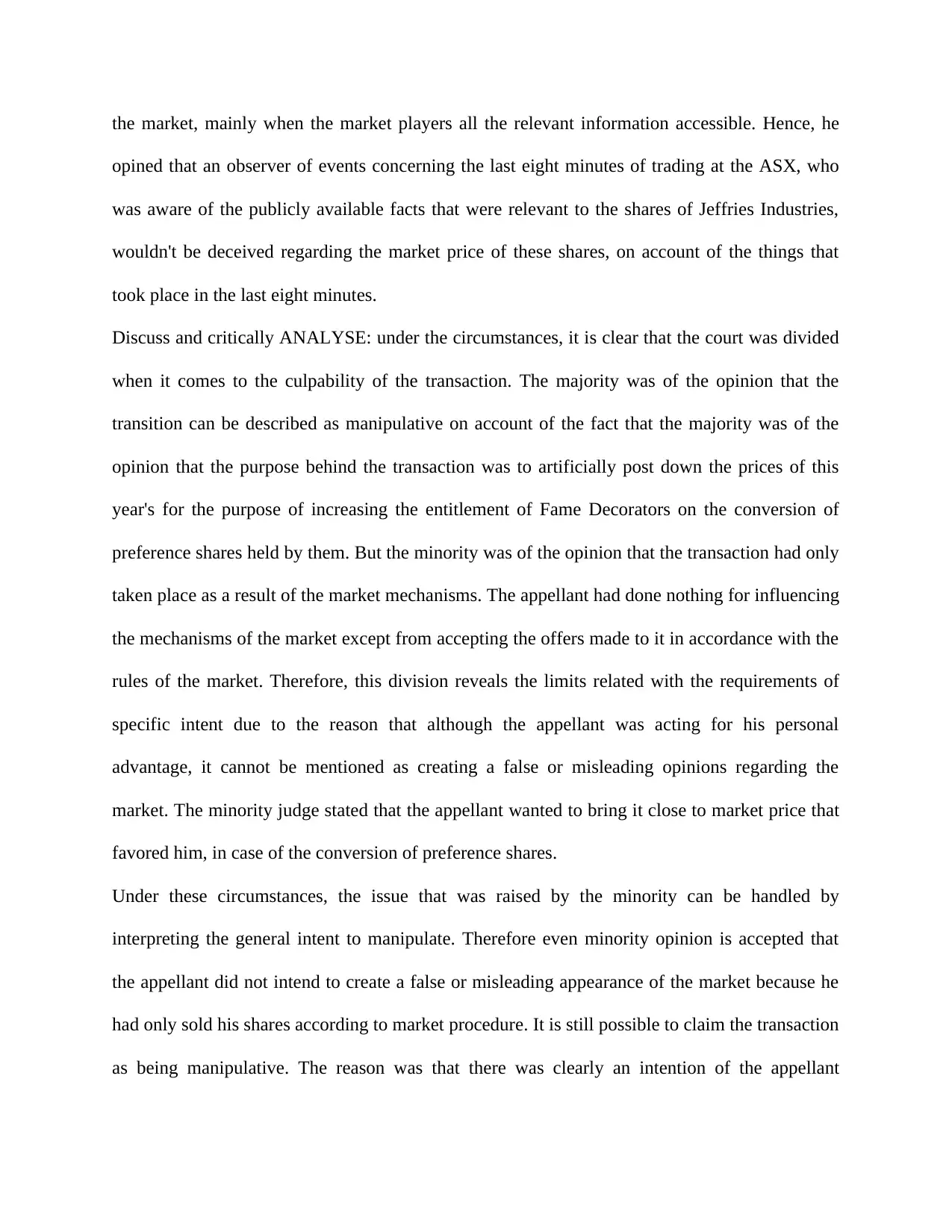
the market, mainly when the market players all the relevant information accessible. Hence, he
opined that an observer of events concerning the last eight minutes of trading at the ASX, who
was aware of the publicly available facts that were relevant to the shares of Jeffries Industries,
wouldn't be deceived regarding the market price of these shares, on account of the things that
took place in the last eight minutes.
Discuss and critically ANALYSE: under the circumstances, it is clear that the court was divided
when it comes to the culpability of the transaction. The majority was of the opinion that the
transition can be described as manipulative on account of the fact that the majority was of the
opinion that the purpose behind the transaction was to artificially post down the prices of this
year's for the purpose of increasing the entitlement of Fame Decorators on the conversion of
preference shares held by them. But the minority was of the opinion that the transaction had only
taken place as a result of the market mechanisms. The appellant had done nothing for influencing
the mechanisms of the market except from accepting the offers made to it in accordance with the
rules of the market. Therefore, this division reveals the limits related with the requirements of
specific intent due to the reason that although the appellant was acting for his personal
advantage, it cannot be mentioned as creating a false or misleading opinions regarding the
market. The minority judge stated that the appellant wanted to bring it close to market price that
favored him, in case of the conversion of preference shares.
Under these circumstances, the issue that was raised by the minority can be handled by
interpreting the general intent to manipulate. Therefore even minority opinion is accepted that
the appellant did not intend to create a false or misleading appearance of the market because he
had only sold his shares according to market procedure. It is still possible to claim the transaction
as being manipulative. The reason was that there was clearly an intention of the appellant
opined that an observer of events concerning the last eight minutes of trading at the ASX, who
was aware of the publicly available facts that were relevant to the shares of Jeffries Industries,
wouldn't be deceived regarding the market price of these shares, on account of the things that
took place in the last eight minutes.
Discuss and critically ANALYSE: under the circumstances, it is clear that the court was divided
when it comes to the culpability of the transaction. The majority was of the opinion that the
transition can be described as manipulative on account of the fact that the majority was of the
opinion that the purpose behind the transaction was to artificially post down the prices of this
year's for the purpose of increasing the entitlement of Fame Decorators on the conversion of
preference shares held by them. But the minority was of the opinion that the transaction had only
taken place as a result of the market mechanisms. The appellant had done nothing for influencing
the mechanisms of the market except from accepting the offers made to it in accordance with the
rules of the market. Therefore, this division reveals the limits related with the requirements of
specific intent due to the reason that although the appellant was acting for his personal
advantage, it cannot be mentioned as creating a false or misleading opinions regarding the
market. The minority judge stated that the appellant wanted to bring it close to market price that
favored him, in case of the conversion of preference shares.
Under these circumstances, the issue that was raised by the minority can be handled by
interpreting the general intent to manipulate. Therefore even minority opinion is accepted that
the appellant did not intend to create a false or misleading appearance of the market because he
had only sold his shares according to market procedure. It is still possible to claim the transaction
as being manipulative. The reason was that there was clearly an intention of the appellant
Paraphrase This Document
Need a fresh take? Get an instant paraphrase of this document with our AI Paraphraser
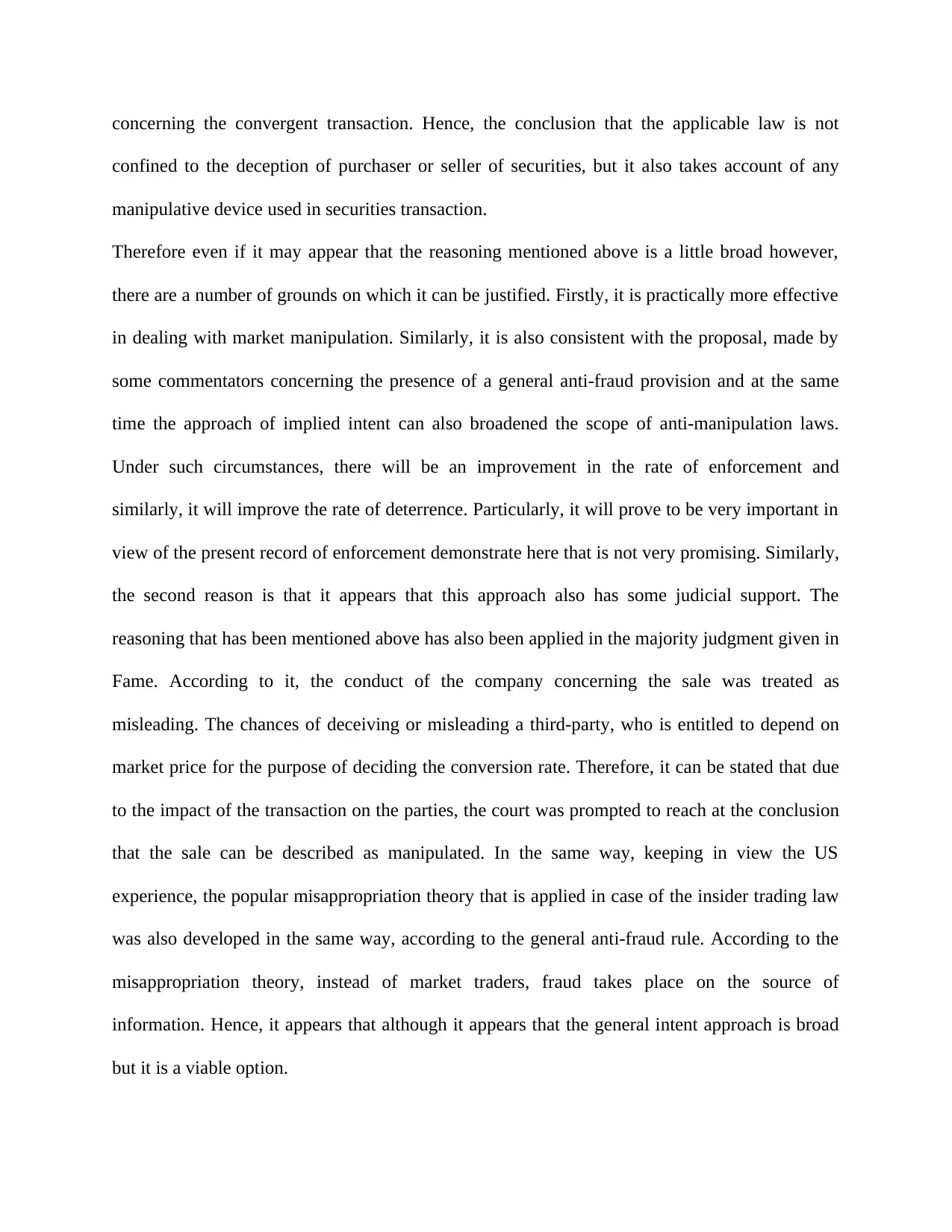
concerning the convergent transaction. Hence, the conclusion that the applicable law is not
confined to the deception of purchaser or seller of securities, but it also takes account of any
manipulative device used in securities transaction.
Therefore even if it may appear that the reasoning mentioned above is a little broad however,
there are a number of grounds on which it can be justified. Firstly, it is practically more effective
in dealing with market manipulation. Similarly, it is also consistent with the proposal, made by
some commentators concerning the presence of a general anti-fraud provision and at the same
time the approach of implied intent can also broadened the scope of anti-manipulation laws.
Under such circumstances, there will be an improvement in the rate of enforcement and
similarly, it will improve the rate of deterrence. Particularly, it will prove to be very important in
view of the present record of enforcement demonstrate here that is not very promising. Similarly,
the second reason is that it appears that this approach also has some judicial support. The
reasoning that has been mentioned above has also been applied in the majority judgment given in
Fame. According to it, the conduct of the company concerning the sale was treated as
misleading. The chances of deceiving or misleading a third-party, who is entitled to depend on
market price for the purpose of deciding the conversion rate. Therefore, it can be stated that due
to the impact of the transaction on the parties, the court was prompted to reach at the conclusion
that the sale can be described as manipulated. In the same way, keeping in view the US
experience, the popular misappropriation theory that is applied in case of the insider trading law
was also developed in the same way, according to the general anti-fraud rule. According to the
misappropriation theory, instead of market traders, fraud takes place on the source of
information. Hence, it appears that although it appears that the general intent approach is broad
but it is a viable option.
confined to the deception of purchaser or seller of securities, but it also takes account of any
manipulative device used in securities transaction.
Therefore even if it may appear that the reasoning mentioned above is a little broad however,
there are a number of grounds on which it can be justified. Firstly, it is practically more effective
in dealing with market manipulation. Similarly, it is also consistent with the proposal, made by
some commentators concerning the presence of a general anti-fraud provision and at the same
time the approach of implied intent can also broadened the scope of anti-manipulation laws.
Under such circumstances, there will be an improvement in the rate of enforcement and
similarly, it will improve the rate of deterrence. Particularly, it will prove to be very important in
view of the present record of enforcement demonstrate here that is not very promising. Similarly,
the second reason is that it appears that this approach also has some judicial support. The
reasoning that has been mentioned above has also been applied in the majority judgment given in
Fame. According to it, the conduct of the company concerning the sale was treated as
misleading. The chances of deceiving or misleading a third-party, who is entitled to depend on
market price for the purpose of deciding the conversion rate. Therefore, it can be stated that due
to the impact of the transaction on the parties, the court was prompted to reach at the conclusion
that the sale can be described as manipulated. In the same way, keeping in view the US
experience, the popular misappropriation theory that is applied in case of the insider trading law
was also developed in the same way, according to the general anti-fraud rule. According to the
misappropriation theory, instead of market traders, fraud takes place on the source of
information. Hence, it appears that although it appears that the general intent approach is broad
but it is a viable option.
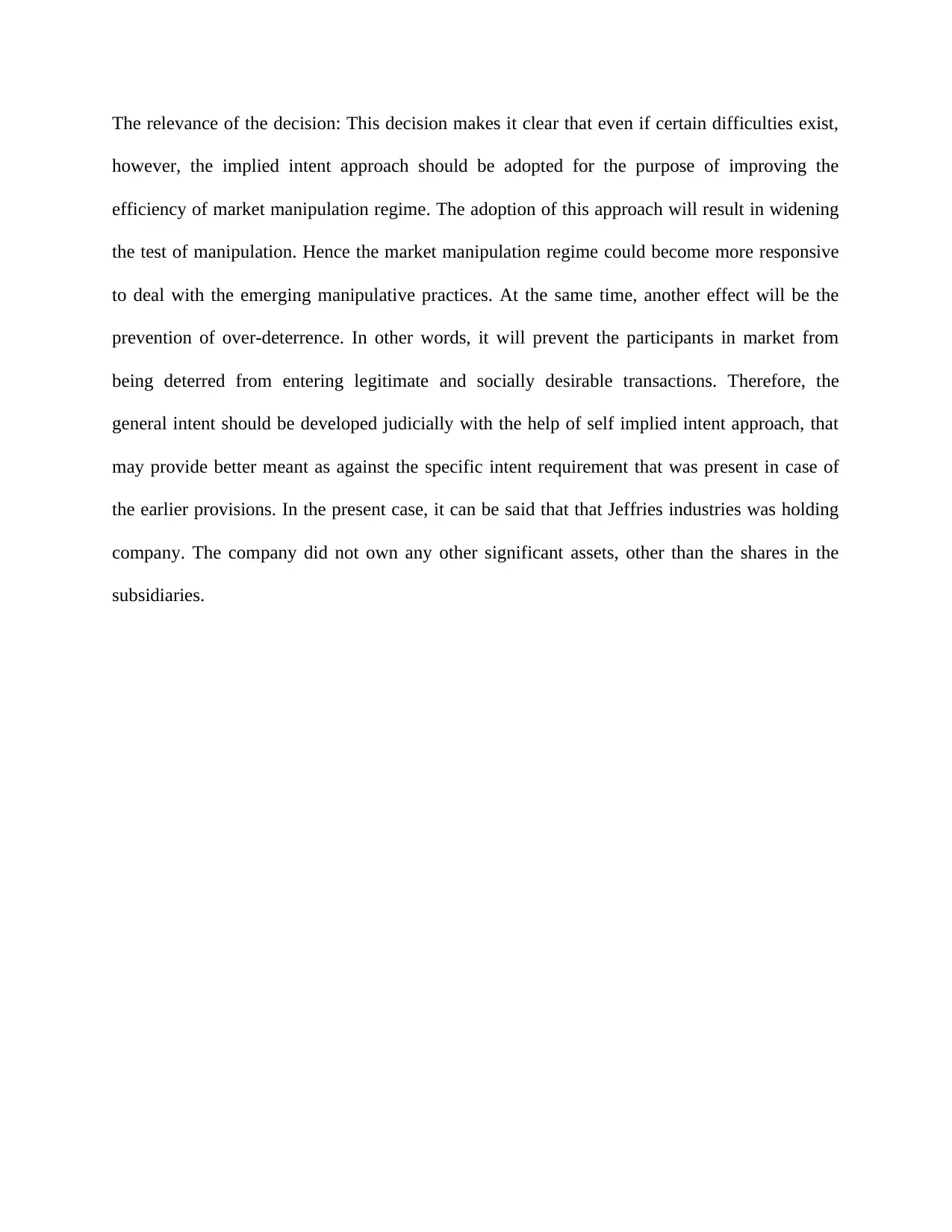
The relevance of the decision: This decision makes it clear that even if certain difficulties exist,
however, the implied intent approach should be adopted for the purpose of improving the
efficiency of market manipulation regime. The adoption of this approach will result in widening
the test of manipulation. Hence the market manipulation regime could become more responsive
to deal with the emerging manipulative practices. At the same time, another effect will be the
prevention of over-deterrence. In other words, it will prevent the participants in market from
being deterred from entering legitimate and socially desirable transactions. Therefore, the
general intent should be developed judicially with the help of self implied intent approach, that
may provide better meant as against the specific intent requirement that was present in case of
the earlier provisions. In the present case, it can be said that that Jeffries industries was holding
company. The company did not own any other significant assets, other than the shares in the
subsidiaries.
however, the implied intent approach should be adopted for the purpose of improving the
efficiency of market manipulation regime. The adoption of this approach will result in widening
the test of manipulation. Hence the market manipulation regime could become more responsive
to deal with the emerging manipulative practices. At the same time, another effect will be the
prevention of over-deterrence. In other words, it will prevent the participants in market from
being deterred from entering legitimate and socially desirable transactions. Therefore, the
general intent should be developed judicially with the help of self implied intent approach, that
may provide better meant as against the specific intent requirement that was present in case of
the earlier provisions. In the present case, it can be said that that Jeffries industries was holding
company. The company did not own any other significant assets, other than the shares in the
subsidiaries.
⊘ This is a preview!⊘
Do you want full access?
Subscribe today to unlock all pages.

Trusted by 1+ million students worldwide
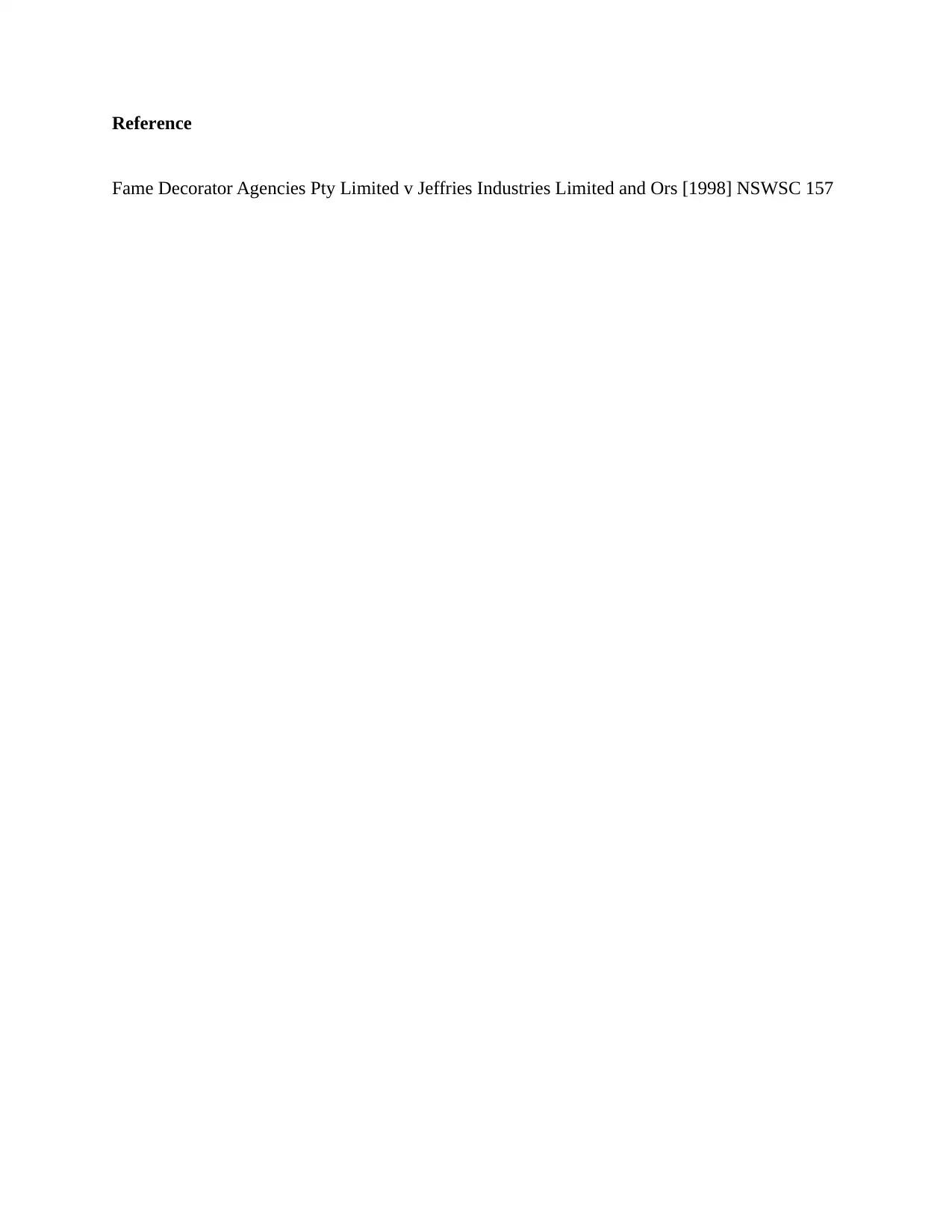
Reference
Fame Decorator Agencies Pty Limited v Jeffries Industries Limited and Ors [1998] NSWSC 157
Fame Decorator Agencies Pty Limited v Jeffries Industries Limited and Ors [1998] NSWSC 157
1 out of 7
Related Documents
Your All-in-One AI-Powered Toolkit for Academic Success.
+13062052269
info@desklib.com
Available 24*7 on WhatsApp / Email
![[object Object]](/_next/static/media/star-bottom.7253800d.svg)
Unlock your academic potential
Copyright © 2020–2025 A2Z Services. All Rights Reserved. Developed and managed by ZUCOL.




